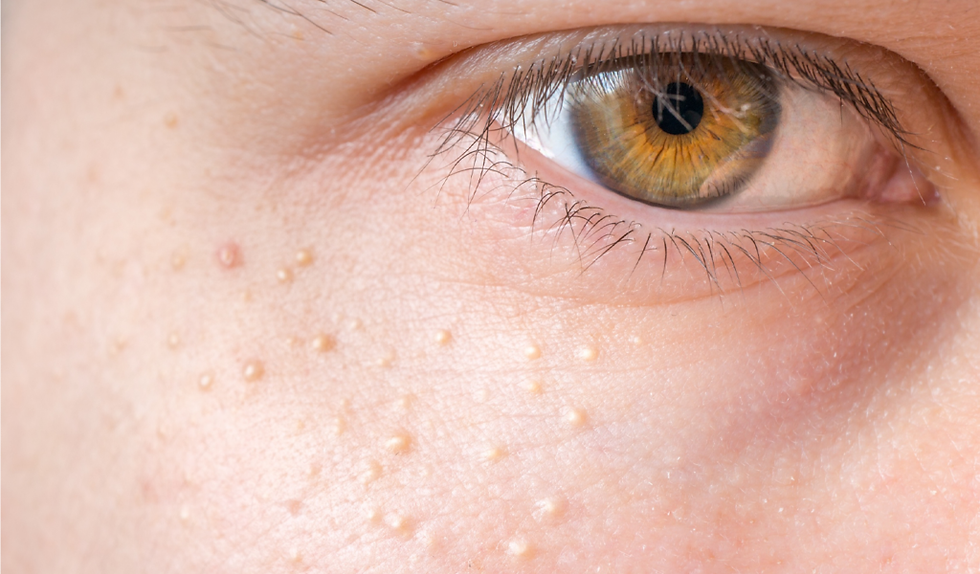Best Milia Treatments for Facial Bumps
- aesthatic clinic
.jpg/v1/fill/w_320,h_320/file.jpg)
- Aug 1
- 3 min read
If you’ve ever noticed tiny, hard white bumps on your face that just won’t go away, chances are you’re dealing with milia. These keratin-filled cysts sit just beneath the surface of the skin, making them resistant to regular face washes or acne treatments. Though harmless, they can be frustrating—especially when they show up around the eyes, cheeks, and forehead. Fortunately, Milia Treatments in Dubai offer advanced, dermatologist-approved solutions designed specifically for these types of skin concerns. Understanding the best treatments available today is the first step toward smoother, clearer skin.
Why Facial Milia Are So Stubborn
Unlike acne, milia do not form in the pore. They occur when dead skin cells get trapped in small pockets beneath the surface, hardening into tiny, pearl-like bumps. These bumps don’t have an opening to the surface, which is why they don’t come out with scrubbing or squeezing. In fact, trying to pop them can lead to redness, irritation, or scarring—making professional treatment the safest and most effective route.

Top Treatment Options for Milia on the Face
Modern dermatology offers several non-invasive procedures that can safely and effectively remove milia from the face. These treatments are typically quick, require little to no downtime, and yield long-lasting results.
Manual Extraction
This is often the first option for many patients. A licensed skincare professional uses a sterile needle or a comedone extractor to carefully open the bump and release the keratin inside.
Works well for isolated or small clusters of milia.
Minimal discomfort with instant improvement.
Avoid attempting this at home, as it requires proper technique and hygiene.
Chemical Peels
Chemical exfoliants like glycolic acid, lactic acid, or salicylic acid help remove dead skin layers that may be trapping keratin. Peels are especially useful for those prone to recurring milia.
Enhances skin texture.
Promotes cell turnover.
Helps prevent future outbreaks.
Topical Retinoids
For persistent or widespread facial milia, topical retinoids are often prescribed. These vitamin A-based creams increase skin turnover and help unclog the skin.
Useful for ongoing maintenance.
Particularly effective around the forehead and chin.
May cause mild peeling or dryness initially.
Microdermabrasion
This procedure gently exfoliates the uppermost layers of skin using a fine abrasive tool. It’s suitable for individuals with sensitive skin who want a gentle option.
Non-invasive and pain-free.
Improves overall skin texture.
Can be repeated regularly for maintenance.
Laser Resurfacing
In cases of stubborn or deep-set milia, fractional lasers may be used to vaporize the top layer of the skin and open up the cysts.
Delivers precision.
Boosts collagen production.
Can also treat fine lines and pigmentation alongside milia.
Choosing the Right Treatment for Your Skin Type
Not all milia treatments are created equal. Your skin type, tone, and sensitivity should all factor into which approach is best for you. For example:
Oily or acne-prone skin: May benefit from chemical peels and retinoids.
Dry or sensitive skin: Microdermabrasion and gentle extractions are better suited.
Darker skin tones: Treatments must be selected carefully to avoid post-inflammatory pigmentation.
A consultation with a qualified skincare specialist is key to tailoring the right plan.
Home Care to Support Results
Although professional treatment is the main solution for removing milia, certain habits can help prevent them from returning:
Use oil-free and non-comedogenic products.
Avoid thick or occlusive creams, especially around the eyes.
Gently exfoliate once or twice a week.
Protect your skin daily with SPF 30+.
Wash your face thoroughly before bed to remove makeup and sunscreen.

Are These Treatments Long-Lasting?
Yes, milia that are professionally extracted typically do not come back in the same place. However, new ones may appear in the future, particularly if you continue using heavy skincare or live in a climate with high sun exposure. Regular maintenance treatments can help keep your skin clear long-term.
Milia Treatments for Facial Skin Health
Given Dubai’s sunny climate and increasing focus on aesthetics, Milia Treatments Dubai are designed to meet both cosmetic and medical needs. From targeted extractions to laser-based methods, treatments here are delivered using world-class technology, personalized for each skin type. Whether you're dealing with a few bumps or chronic flare-ups, the local skincare scene offers expert-driven, safe, and proven solutions.
Conclusion
Facial milia may be harmless, but that doesn’t mean you have to live with them. Thanks to advancements in skincare, you now have a wide range of treatment options that are both safe and effective. Whether you're seeking instant results with manual extraction or looking for long-term improvement through chemical peels or retinoids, the right solution exists for every skin type. And in a city where skin health is taken seriously, the best treatments are right at your fingertips.









Comments